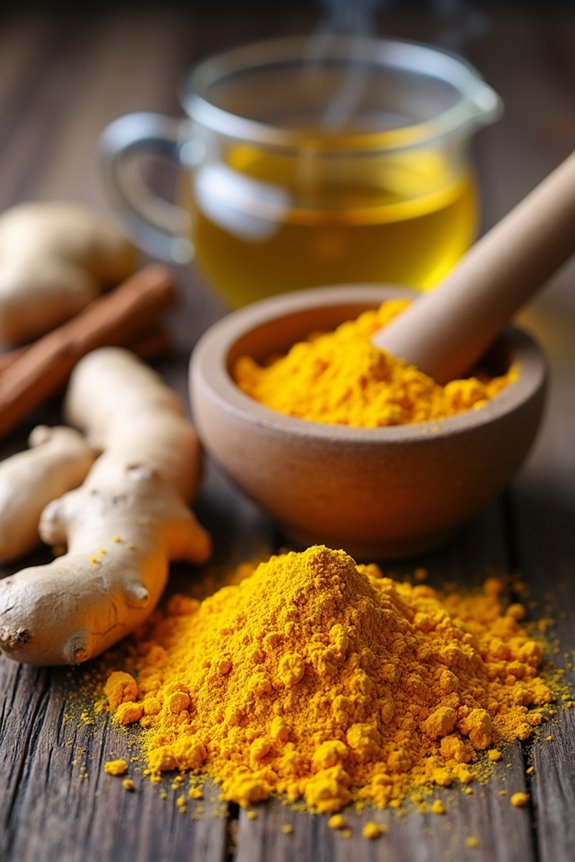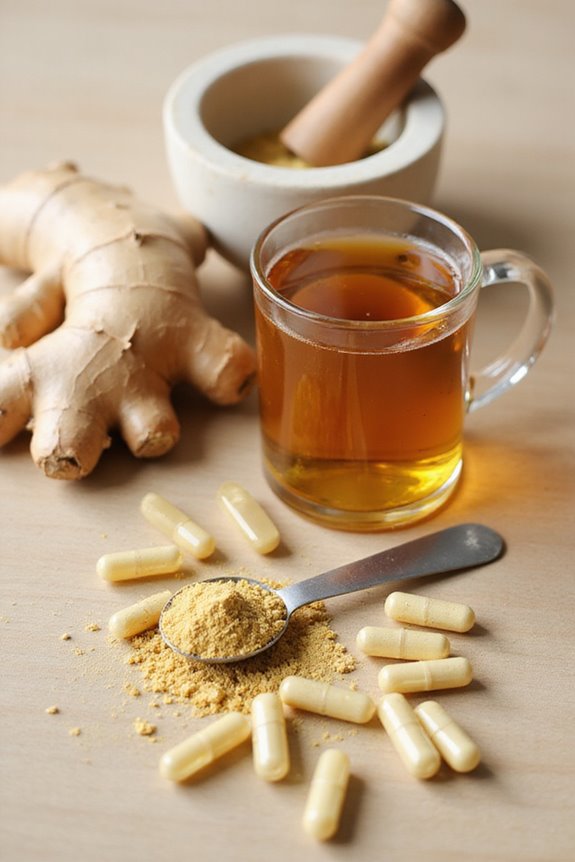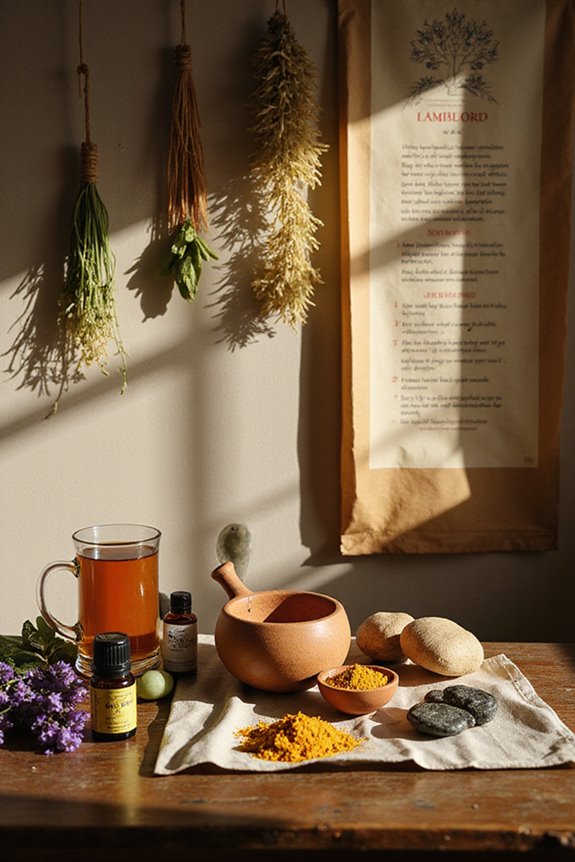Turmeric reduces inflammation primarily due to curcumin, its key bioactive compound. Curcumin inhibits NF-kappaB, leading to decreased pro-inflammatory cytokines such as TNF-alpha and IL-6. It scavenges reactive oxygen species, mitigating oxidative stress, and suppresses multiple inflammatory mediators. Studies indicate curcumin’s effectiveness in reducing joint pain and systemic inflammation in conditions like arthritis. However, curcumin’s low bioavailability and variability in quality present practical challenges. Understanding these factors will provide further insights into its therapeutic potential.
Key Takeaways
- Turmeric contains curcumin, which inhibits NF-kappaB, reducing pro-inflammatory cytokines like TNF-alpha and IL-6.
- Curcumin scavenges reactive oxygen species, mitigating oxidative stress and inflammatory signaling pathways.
- It inhibits COX-2 and iNOS, decreasing the production of pro-inflammatory mediators.
- Curcumin modulates EGR-1, STAT3, and Sp-1 pathways, enhancing anti-inflammatory effects and potential anti-cancer properties.
- Clinical trials show curcumin supplementation reduces joint pain and inflammation by suppressing inflammatory biomarkers.
Key Bioactive Compound: Curcumin
Curcumin, the primary bioactive compound in turmeric, plays an essential role in the herb’s therapeutic properties. This compound constitutes approximately 3% to 10% of turmeric powder by weight, with raw turmeric containing only 2 to 6% curcumin. These concentrations limit the effectiveness of turmeric as consumed in typical diets.
Isolated curcumin extracts are preferred in clinical settings due to their higher curcumin dosage, which offers more consistent anti-inflammatory results compared to whole turmeric.
However, variability in curcumin sources, including potential adulteration, raises concerns regarding the reliability of turmeric powder for therapeutic uses. Consequently, clinical trials mainly utilize curcumin extracts to achieve measurable therapeutic effects, highlighting the importance of formulation and bioavailability.
Mechanism of Action in Inflammation
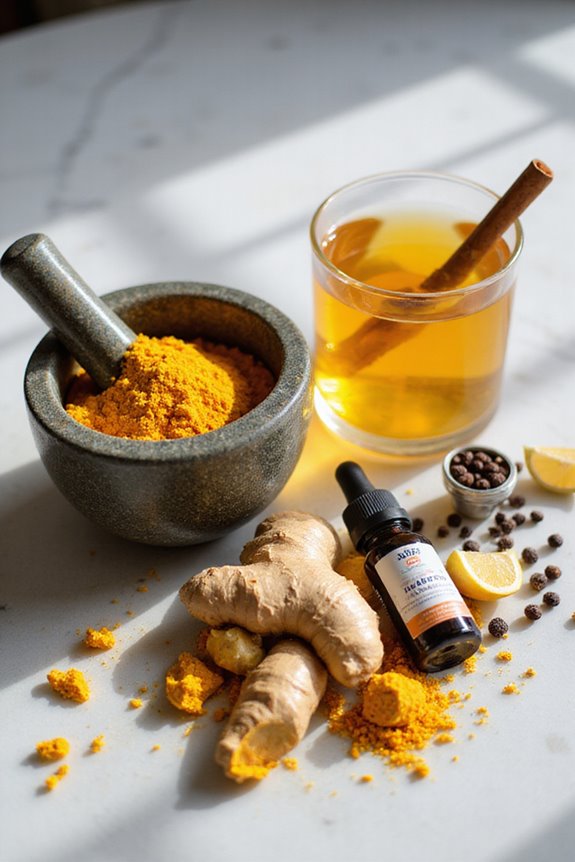
The mechanisms through which turmeric exerts its anti-inflammatory effects are multifaceted and complex. Curcumin properties play an essential role in targeting various inflammation pathways:
- Inhibition of NF-kappaB: Curcumin inhibits this key mediator, reducing pro-inflammatory cytokines like TNF-alpha and IL-6.
- Scavenging Reactive Oxygen Species: Curcumin mitigates oxidative stress by neutralizing harmful reactive oxygen species, thereby lowering inflammatory signaling.
- Enzymatic Inhibition: It inhibits COX-2 and iNOS, decreasing pro-inflammatory mediators.
- Suppression of EGR-1: This transcription factor’s inhibition helps modulate acute and chronic inflammation.
- Modulation of STAT3 and Sp-1: Curcumin affects these pathways, enhancing its anti-inflammatory and anti-cancer potential.
Together, these mechanisms highlight curcumin’s extensive role in managing inflammation and its associated effects.
Effects on Chronic Diseases
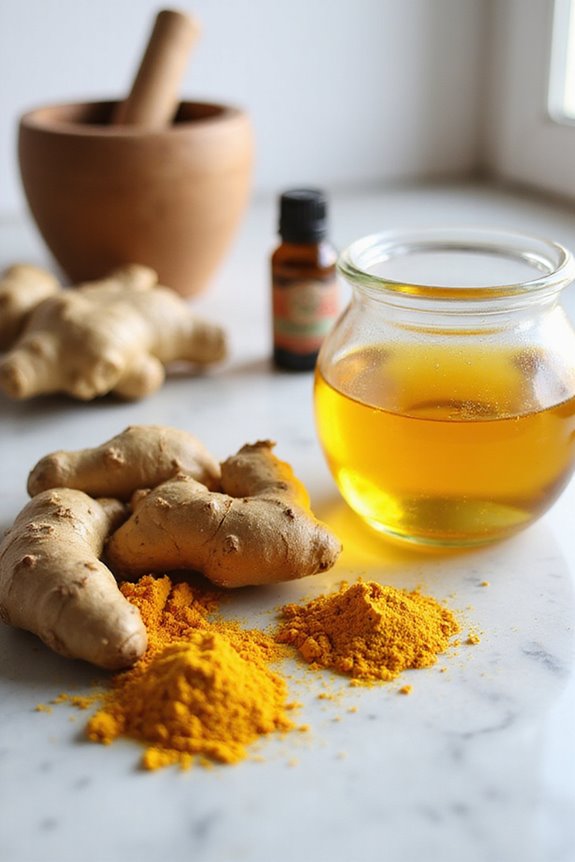
Turmeric, particularly through its active compound curcumin, has garnered attention for its potential effects on various chronic diseases. The turmeric benefits extend to several chronic conditions, including:
- Arthritis and Joint Diseases: Curcumin may alleviate joint pain and swelling, although clinical evidence remains limited regarding its effectiveness compared to standard treatments.
- Cardiovascular and Metabolic Conditions: Curcumin shows promise in reducing systemic inflammation and managing cholesterol levels, yet robust clinical trials are necessary to confirm these effects.
- Neurodegenerative Disorders: Curcumin might enhance brain-derived neurotrophic factor (BDNF), potentially benefiting cognitive function and mood.
- Gastrointestinal and Kidney Conditions: Some studies indicate turmeric may assist with inflammation in gastrointestinal disorders and kidney issues, but conclusive evidence is lacking.
Further research is essential to validate these findings.
Evidence From Human and Animal Studies
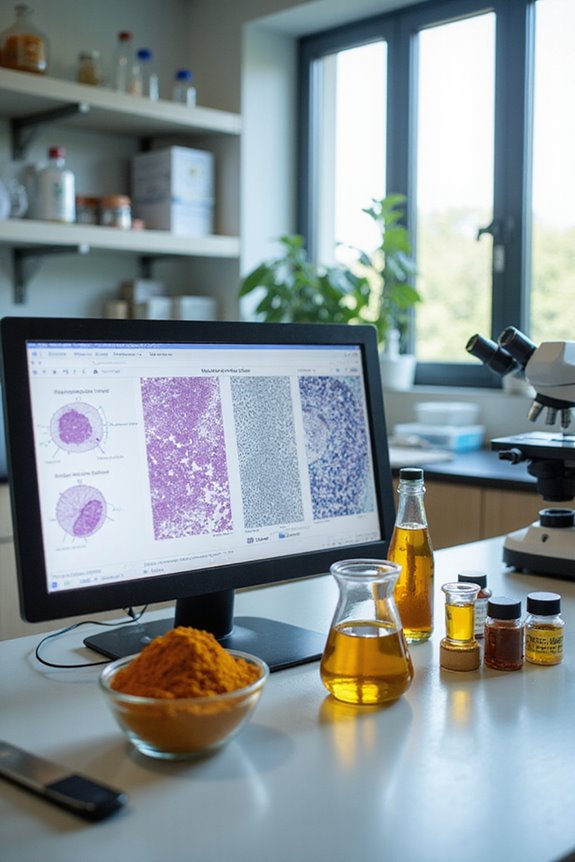
Research into the anti-inflammatory properties of turmeric and its primary active compound, curcumin, has yielded substantial evidence from both human clinical studies and animal models.
Human Clinical Studies:
- Clinical trials indicate reduced joint pain and inflammation in osteoarthritis patients with turmeric or curcumin supplementation.
- Evidence shows improvements in arthritis symptoms through suppression of pro-inflammatory cytokines and enzymes.
- Reported reductions in inflammatory biomarkers validate systemic anti-inflammatory effects.
Animal Models:
- Curcumin administration in animal models suppresses inflammatory responses by downregulating NF-kB and related pathways.
- Studies demonstrate decreased inflammation and tissue damage in models of gout and arthritis.
- Curcumin shows neuroprotective effects and reduces oxidative stress markers, indicating broader systemic benefits.
Both human and animal research collectively support curcumin’s significant anti-inflammatory potential.
Limitations and Practical Considerations
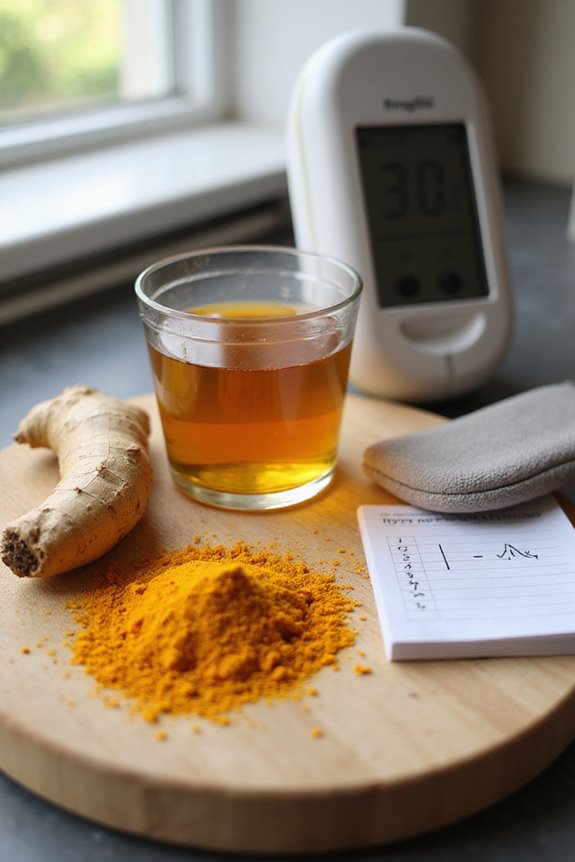
While turmeric is widely recognized for its potential anti-inflammatory properties, several limitations and practical considerations must be acknowledged.
Bioavailability Challenges
- Curcumin, the active compound, has low bioavailability due to poor absorption and rapid metabolism.
- Dietary turmeric contains only 2% to 6% curcumin, limiting effective intake.
Dosage Limitations
- Clinical studies indicate effective doses range from 100 mg to 2000 mg daily, with side effects, particularly above 1200 mg.
- Long-term safety data are lacking, raising concerns about high-dose use.
Product Quality
- Commercial turmeric products vary greatly in quality and curcumin content, posing risks of contamination.
- Consumers must prioritize products tested for purity to avoid synthetic additives and harmful substances.
Frequently Asked Questions
Can Turmeric Be Used Topically for Inflammation Relief?
In the garden of healing, turmeric emerges as a vibrant bloom, offering topical applications for inflammation relief. Its potent properties, rooted in ancient wisdom, embrace those seeking solace from skin ailments, fostering a sense of community and hope.
Are There Any Side Effects of Turmeric Consumption?
Turmeric consumption may lead to gastrointestinal side effects, especially at high dosages. Individuals with turmeric allergies should exercise caution, as reactions can vary. Awareness of these potential issues fosters a supportive community focused on health and well-being.
How Much Turmeric Should I Take Daily?
Amidst the quest for wellness, turmeric dosage recommendations suggest a daily turmeric intake of 500 to 2,000 mg, tailored to individual needs. This potent spice has captivated health enthusiasts, promising vibrant energy and holistic harmony.
Is Turmeric Safe for Pregnant or Breastfeeding Women?
Turmeric is generally safe in culinary amounts for pregnant and breastfeeding women. However, high turmeric dosages are discouraged. While turmeric benefits include potential antioxidant properties, caution and professional consultation are advised for supplementation during these periods.
Can Turmeric Interact With Medications or Supplements?
Turmeric interactions with various medications can considerably alter medication effects. By influencing drug metabolism, absorption, and efficacy, turmeric necessitates careful consideration and professional guidance to guarantee safety and ideal therapeutic outcomes for individuals seeking health benefits.

